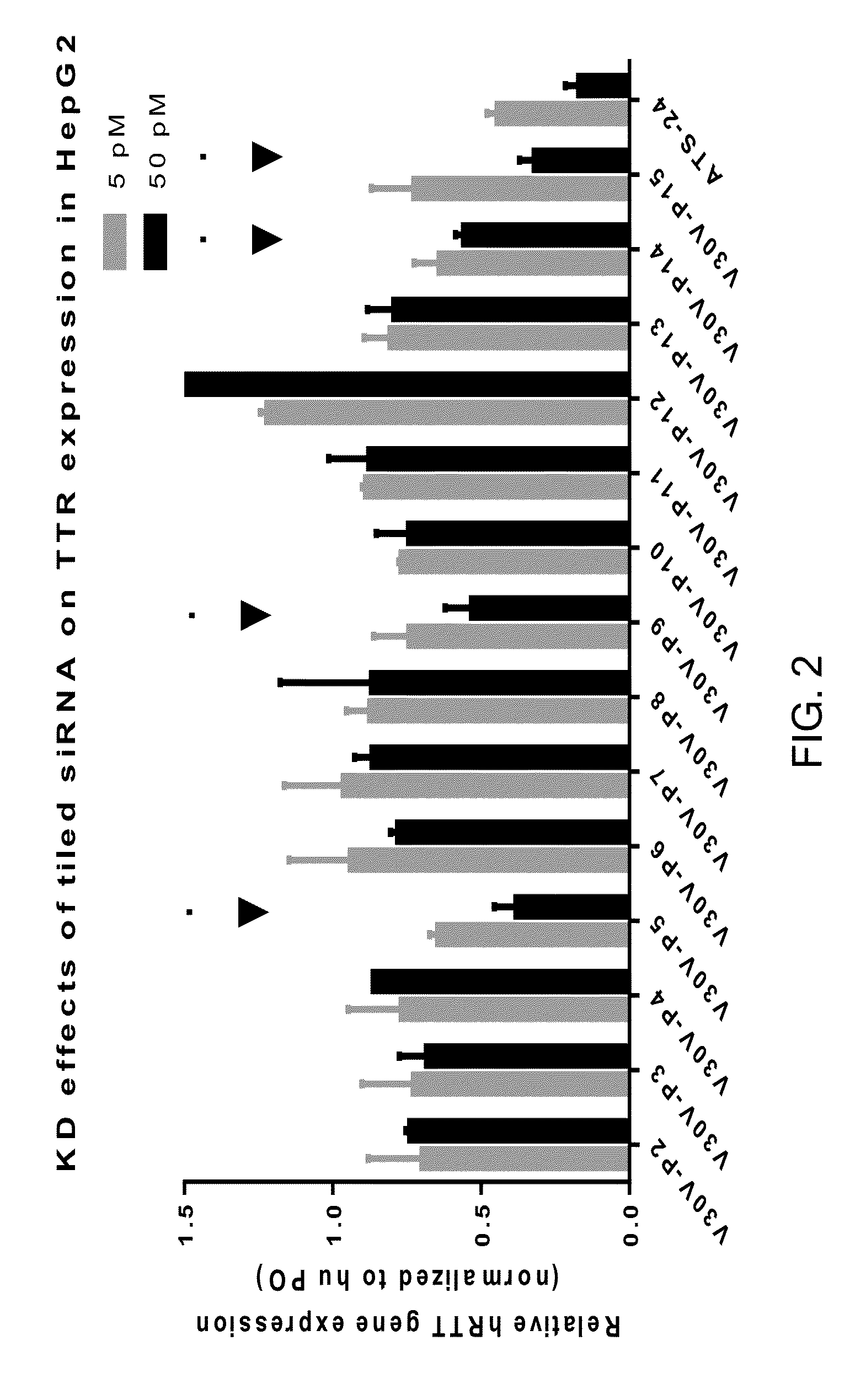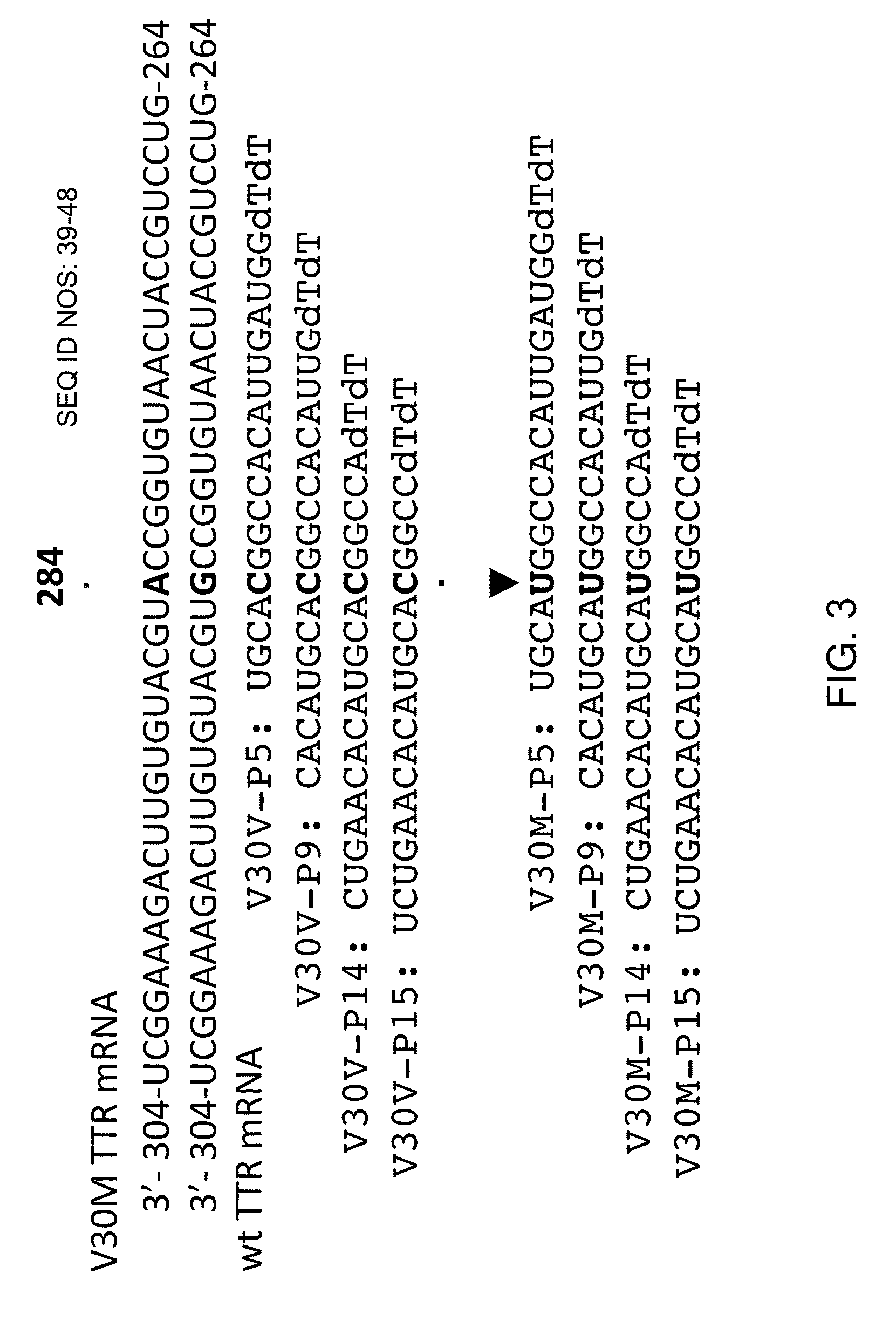Transthyretin allele selective una oligomers for gene silencing
a technology of transthyretin and una oligomer, applied in the direction of biocide, group 5/15 element organic compounds, drug compositions, etc., can solve the problems of peripheral neuropathy, pain, and inability to carry a pacemaker, and achieve the effect of reducing peripheral neuropathy
- Summary
- Abstract
- Description
- Claims
- Application Information
AI Technical Summary
Benefits of technology
Problems solved by technology
Method used
Image
Examples
example 1
[0161]FIG. 1 shows the single nucleotide polymorph (SNP) that exists at position 284 in the V30M mutation of the human TTR mRNA, as compared to the wild type (WT) TTR mRNA. Conventional siRNAs that are complementary to the WT mRNA were tiled around position 284. FIG. 2 shows that the conventional siRNAs complementary to the WT mRNA have limited activity in silencing the WT TTR gene, as measured by TTR knockdown in HepG2 cells. Positions 5, 9, 14 and 15 appear to be more accessible to silencing than other positions. FIG. 3 shows conventional siRNAs that were complementary to the V30M mRNA were tiled around position 284. Four conventional siRNA variations, namely V30M-P5, V30M-P9, V30M-P14, and V30M-P15, were prepared. Also, as shown in FIG. 3, two gene reporter variants, V30V and V30M, each bearing nucleotide sequence 264 to 304 of human TTR, V30V being without the point mutation at position 284, and V30M containing the point mutation at position 284, were prepared and used in the PS...
example 2
[0162]FIG. 4 shows the activity of the four conventional siRNA variations V30M-P5, V30M-P9, V30M-P14, and V30M-P15 as measured in the PSICHECK reporter assay against V30V and V30M gene reporter variants. The conventional siRNA variations V30M-P5, V30M-P9, and V30M-P15 were more effective against V30M than V30V. The conventional siRNA variation V30M-P14 was not more effective against V30M than V30V. FIG. 5 shows IC50 analysis for the four conventional siRNA variations V30M-P5, V30M-P9, V30M-P14, and V30M-P15 measured in the PSICHECK reporter assay against V30V and V30M gene reporter variants. The conventional V30M-P15 variant was 5.6 times more effective against V30M than V30V. Thus, the selectivity of the conventional siRNAs against V30M over V30V was no more than 5.6.
example 3
[0163]FIG. 6 shows the structure of UNA oligomers that were effective in silencing V30M TTR, as measured in the PSICHECK reporter assay. Each of the UNA oligomer embodiments, P15U6, P15U7, P15U14, P15U15, and P15U16, contained four UNA monomers. In each UNA oligomer, a first UNA monomer was located at the 5′ end of the first strand, also called the passenger strand. In each UNA oligomer, the second strand, also called the guide strand, formed a duplex region of 19 monomers length with the first strand. Each UNA oligomer had a duplex region of 19 monomers, and a two-monomer overhang at each end. In each UNA oligomer, a second UNA monomer was located at the 3′ end of the first strand, in the 20th position, which is in an overhang portion. In each UNA oligomer, a third UNA monomer was located at the 3′ end of the second strand, in the 20th position, which is in an overhang portion. In the UNA oligomer embodiments, P15U6, P15U7, P15U14, P15U15, and P15U16, a fourth UNA monomer was locat...
PUM
| Property | Measurement | Unit |
|---|---|---|
| length | aaaaa | aaaaa |
| size | aaaaa | aaaaa |
| pharmaceutical composition | aaaaa | aaaaa |
Abstract
Description
Claims
Application Information
 Login to View More
Login to View More - R&D
- Intellectual Property
- Life Sciences
- Materials
- Tech Scout
- Unparalleled Data Quality
- Higher Quality Content
- 60% Fewer Hallucinations
Browse by: Latest US Patents, China's latest patents, Technical Efficacy Thesaurus, Application Domain, Technology Topic, Popular Technical Reports.
© 2025 PatSnap. All rights reserved.Legal|Privacy policy|Modern Slavery Act Transparency Statement|Sitemap|About US| Contact US: help@patsnap.com



